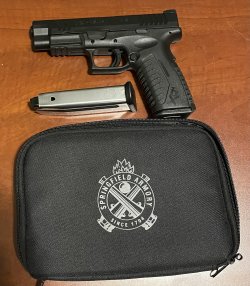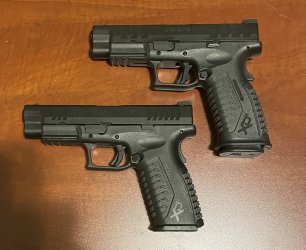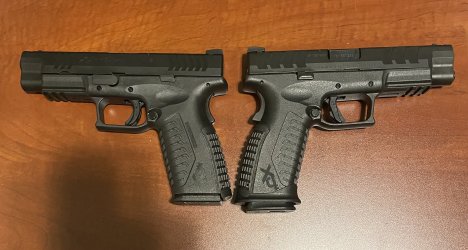The barrel isn't what prints, it's the grip.
^ This is what's true for me, too.
However, that said......
To begin with, concealment is never an absolute - for some folks, a little bit of printing or even an occasional flash of the holster/holster hardware or even the firearm itself isn't a big deal. For others, anything short of the complete disappearance of the firearm is absolutely unacceptable.
@wmg1299 , for-starters, it would help tremendously if you can let us know what side of this sliding-scale you tip towards.

With a larger gun, the need for the support gear to leverage that grip closer to the body becomes very important. Typically, this means that the belt selected will need to be compatible with the holster/mounting hardware's "claw" or "wing" device (an extension at the grip side of the holster, designed to leverage the grip towards the body). More on belts in a second, but first, Harrison of Harry's Holsters has an excellent write-up on these devices and their best (typical) usage -
Concealment claws can be a useful holster accessory but they must be used properly to get an advantage. Hear we go over the knowledge to properly use a claw.

harrysholsters.com
But the holster itself can both help (such as the built-in wedge of various top-tier modern IWB holsters by JM Customs and Keepers Concealment) -and hinder (such as fixed "sidecar" holsters [
PHLster also has a great video on this, and I recommend that anyone considering a fixed sidecar holster first look at this video prior to purchase - but I would, as PHLster noted himself, first view the basic consideration videos below]) - the issue, too. Here, PHLster's video offers a wealth of information -
[
You'll note that he also mentioned that there needs to be considerations of belt type, and that counter to longstanding dogma, it's now been shown that in some instances, for modern IWB holsters, it's actually better to have a belt that is more conforming. ]
Concealed carry of a full-size handgun is definitely possible, given some thought and possibly some trial-and-error with respect to gear. I've seen athletic built men -from someone who is as small as Chris Costa to someone several size bigger- each totally conceal a full-sized handgun (with full-size WML and/or slide-mounted micro-RDS) to the extent that I wasn't able to even tell that they're carrying, with nothing more than a simple T-shirt overtop....
^ I've shown this picture here before, and I honestly can't say if Costa was carrying there or not, but his outfit for all six days of classes that summer was similar, and on at least one occasion - if not more - he was packing a full-sized S&W M&P with a Surefire X300U slung underneath. He was T&E'ing gear at that point, and I believe what he had was either the Armordillo X-fer or RCS VG3).
And while my daughter is not of legal age to conceal-carry, I did mock-up gear for her at one point recently, and showed her how easy it was for a woman of even her build -5'4" or so, 125 lbs., athletic, with very modest bosom- to easily conceal a full-sized handgun, even in the tighter-fitting clothes that the youth currently considers fashionable. We used for this demo my full-sized 4.5-inch XDm9 in a PHLster Floodlight holster that's in-turn mounted to her Volund Gearworks ATLAS-slim belt via DDC clips. Almost a mirror-copy of this gear setup was used by a young man I'd met at a concealment pistol class I took in the summer of 2018 - his slim-athletic build, combined with his height (6'2", minimum) meant that even a rather clingy UnderArmour shirt still allowed enough "drape" at his waist to allow him to conceal, to a surprising depth, a full Glock 19 "Roland Special," in that same holster, AIWB.
@wmg1299 , I think that starting this discussion off by letting us know just what level of concealment is acceptable for you would be a great beginning.
From there, we can then explore whether that's going to be a realistic possibility given your body build/shape, your preference in gear (as well as gear setup - i.e. the compromise between ride-height and grip leveraging versus accessibility, etc.), and your typical style and manner of dress.




